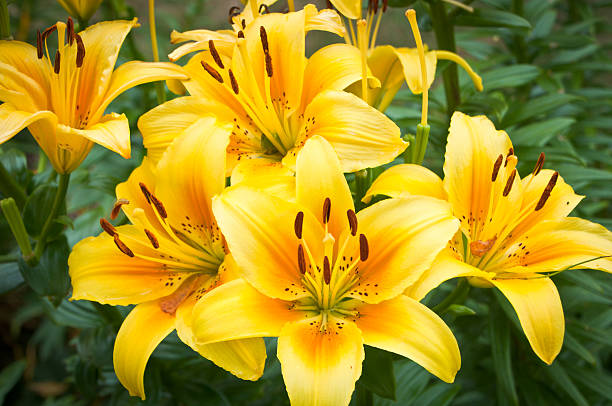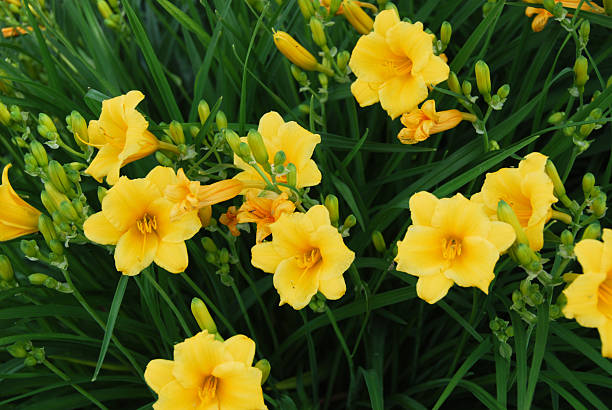Why Are My Daylily Leaves Turning Yellow? —Find Out the Reasons Why
Daylilies are a popular plant for both homeowners and garden enthusiasts. When they are healthy, their leaves are a vibrant green, but when something goes wrong, they can turn yellow or even brown. Several factors can cause it. Continue reading!
Table of Contents
Factors Why Daylily Leaves Are Turning Yellow

It’s a Natural Cycle
There will be times when the yellowing of daylilies will be completely normal and unavoidable. After reaching the end of the growing season, daylilies turn yellow to signal the end of the growing season and the beginning of the next cycle. The daylilies will do this on their own accord, and it is perfectly normal for them to do so. The growing season for daylilies takes place during the months of spring and summer, respectively. Daylilies will bloom in the spring and then thrive throughout the summer months. The leaves will inevitably begin to turn yellow once the cooler fall temperatures arrive.
It occurs due to the daylilies’ inability to complete the photosynthesis process properly. You’ll notice that the yellow leaves are turning brown and collapsing at some point during the late fall. Weather conditions in some areas have caused some deviations from this information, so please check your local weather forecast. If you’re growing daylilies in a region of the world where the weather is consistently warm for longer periods, the yellowing may appear later in the season.
Incorrect Watering Schedule
Inadequate Watering. Daylilies can turn yellow due to not providing enough water for them. Even though daylilies are relatively simple to grow and care for, they will require a lot of water when they are young and attempting to establish themselves.
If you do not provide them with the water they require during this period, you may notice some yellowing of the leaves. When newly planted daylilies begin to show signs of yellowing, the concern is almost always due to a lack of water being provided to them.
To get good results from your plants during the growing season, you must provide them with plenty of water. Prevent the soil from becoming completely dry by ensuring that the plants receive adequate moisture.
According to some sources, the plants require approximately one inch of water per week. Rainwater is included, which means that you must keep an eye on the amount of precipitation falling in your area.
Overwatering. Excessive watering of daylilies can also cause yellowing of the flowers. When you make the soil soggy and continue to water the daylilies even when they don’t require additional water, you will cause root rot.
Root rot has the potential to kill plants, so it’s something you want to avoid at all costs if at all possible when gardening. When root rot occurs, the roots begin to become slimy, mushy, and brown in appearance over some time.
Aside from that, you’ll notice that the leaves of the daylilies are turning yellow and beginning to wilt. Daylilies are likely to die due to root rot, which is terrible.
Ensure that you only water daylilies when the top inch of soil begins to feel dry. It will help to prevent this from happening. Another consideration is whether or shouldn’t be planted in a perpetually wet location.

Lack of Sunlight
In the same way, as most other species, the Daylilies enjoy the sun’s rays. They thrive in full sun for four to six hours a day in moist, well-draining soil that is well-drained. Insufficient light or shade causes the Daylilies plant to lose the color of its flowers. Daylilies thrive in balconies, rooftops, and outdoor gardens, where they can thrive in full bloom.
Plants such as Daylilies rely on sunlight to make their food and preserve the flowers’ distinctive hue. As a result, if your Daylilies aren’t getting enough sunlight, their yellow leaves may be another contributing factor. Daylilies can brighten your day for years if grown in the right conditions.
Disease
A disease could cause yellowing. Daylilies are susceptible to two diseases that cause them to turn yellow. An infection known as leaf streak can result in long yellow streaks on the leaves. Starting at the leaf tips, it progresses to the entire leaf and eventually causes browning and death.
Another disease to watch out for is daylily rust, which can cause orange spots on the flowers. People sometimes confuse the orange spots for the yellow ones because they look similar depending on the circumstances.
Pests
Your daylilies’ leaves may turn yellow if pests attack them. Plants can become infested with pests like aphids or mites, causing the leaves to yellow over time. Spraying the plants with insecticide or using insecticidal soap will help protect them from this. This type of soap is used regularly to keep plants free of pests for some gardeners.
It’s a good idea to take care of insect problems before they get out of hand. Your daylilies may die or look unhealthy if you don’t watch out for this potential problem. You watched for any signs that insects were harming your plants. Aphids, for example, can leave behind web-like structures on leaves.
Wrong Amount of Fertilizer
Whether it is used every day or once every six months, Fertilizer has a big impact on the growth of flowering plant species. If the Daylilies plant isn’t fed enough or if the Fertilizer doesn’t have enough minerals in it, the plant’s leaves turn yellow.
It’s best to use a high-quality fertilizer that has a lot of nitrogen and potassium to get the best results, though. These things help the plant have a strong structure and healthy metabolism. As long as the soil has a good amount of minerals, you don’t have to fertilize it as much often as. However, you should add a feed on average soil in the spring and again in late summer or the fall.
The mineral phosphorus is essential to plant growth and healthy flower development. It is found in the soil, and when it is not available, the leaves on daylilies start to yellow and fall off. Add a phosphate supplement to your garden soil every year to prevent this from happening. It will help to ensure that your daylilies have enough phosphorus to stay healthy and flower consistently.
